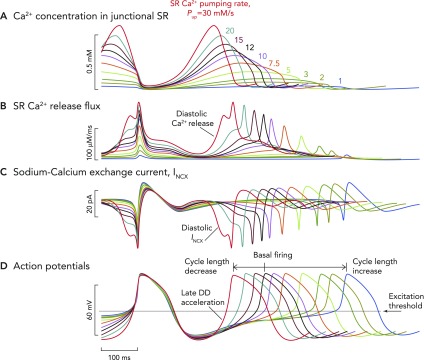FIGURE 7.
Computer model simulation of a biophysically detailed SANC
Computer model simulation of a biophysically detailed SANC incorporating coupled membrane and Ca2+ clock mechanisms of automaticity, illustrating the wide variety of pacing rates that can be achieved simply by varying the pumping rate (Pup) of Ca2+ back into the SR (in vivo, this occurs via the action of the SR ATPase SERCA). Variable SR Ca2+ pumping rates are an index of the degree of phosphorylation of the regulatory molecule phospholamban, which acts as a molecular brake on the pumping rate of SERCA. With increasing degrees of phospholamban phosphorylation, the brake on SERCA functioning is released, and Ca2+ pumping proceeds at a greater rate. The inverse is true when levels of phosphorylation decrease: rate of Ca2+ pumping by SERCA back into the SR decreases. It is likely that the level of phospholamban phosphorylation also reflects the degree of phosphorylation (and therefore activation) of other key mediators of automaticity, including L-type Ca2+ channels, RyRs, and delayed rectifier K+ channels. The maximum rates of SERCA Ca2+ pumping are shown in A. Baseline rates of pumping are shown by the black waveform and are set at rates of 12 mM/s, although they can be varied in the model between 1 and 30 mM/s. A modeled increase in the rate of SERCA Ca2+ pumping causes earlier and larger magnitude Ca2+ release flux from RyRs (B), meaning that, at faster pumping rates, INCX is activated earlier and with a greater magnitude (C). This means that the time to achieve the threshold potential from maximum diastolic potential for the firing of an action potential is progressively shorter. Hence, greater SR Ca2+ pumping rates cause progressively shorter cycle lengths (D). The opposite is true for slower rates of SR Ca2+ pumping: later occurring, smaller RyR Ca2+ release flux, with later occurring, smaller INCX, leading to longer periods of time to achieve threshold potential for firing of an action potential, leading to slower beating rates. Such a mechanism would allow a wide variability in heart rate sufficient to satisfy the majority of demands placed on the system by the organism in vivo.

